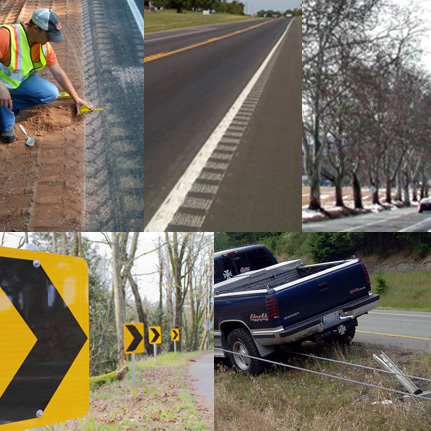U.S. Department of Transportation
Federal Highway Administration
1200 New Jersey Avenue, SE
Washington, DC 20590
202-366-4000
NOTEWORTHY PRACTICE


FHWA-SA-18-070
PDF Version [1.6 MB]
States responsible for maintaining significant road-miles on rural facilities often face a difficult challenge in both collecting adequate data to conduct traditional safety analysis and identifying areas in need of safety treatments. Even agencies that do have extensive data on rural road safety conditions face challenges due to the relatively low average daily traffic on these rural roads, making accurate analysis problematic.

Since 2011, KDOT has focused its HRRR funds on low cost countermeasures such as installing the SafetyEdgeSM pavement markings, rumble strips, tree removal, enhanced signing and improvements to roadside barriers such as culvert headwalls and guardrails. Source: FHWA
Prior to 2010, Kansas was facing a challenge in identifying projects that could qualify for High Risk Rural Road funding.
"We were trying to do everything through data-driven justification. The problem was, we didn't have a lot of detailed data," said Tod Salfrank, the Assistant Bureau Chief for Local Projects at Kansas Department of Transportation (KDOT).
In 2010, the agency was able to fund about half of the project proposals submitted by counties based on criteria that included documented crash records indicating a history of fatal and severe injury crashes exceeding the statewide average for similar roads. However, KDOT realized that a lack of site-specific rural road data along with the randomness of crashes on county roads restricted the agency's ability to complete data-driven analysis. The push to think outside the box was on.
Kansas had used the systemic approach successfully on lighting and pavement marking projects funded through the State's Highway Safety Improvement Program, but not on local road projects. While working to conceptualize a new project selection methodology, staff in the Bureau of Local Projects connected the systemic concept to the rural road challenge. The result was a white paper that became the basis for KDOT's HRRR program, allowing the agency to apply low-cost treatments systemically on county roads.1
"We realized we were not going to move the numbers on the local network if we only do one or two big projects per year [with our funding]," said State Safety Engineer Steven Buckley, who oversees the State's Strategic Highway Safety Plan (SHSP). "As part of our SHSP, we have a Local Roads Emphasis Area Team. Using a low-cost systemic approach was routinely discussed at team meetings, and it was unanimously agreed to be good idea," Buckley added.
With FHWA's concurrence, KDOT established an HRRR program that uses a systemic approach to address roadway departure crashes on major and minor rural collectors and other paved rural county roads. Based on the data available, KDOT focused the program on reducing roadway departures to decrease the most common rural fatality crash type on non-State rural roads: collision with a fixed object. KDOT focuses its HRRR funds on low cost countermeasures such as installing the SafetyEdgeSM, pavement markings, rumble strips, tree removal, enhanced signing and improvements to roadside barriers such as culvert headwalls and guardrails.
According to Salfrank, these locations are "the most likely place for unfamiliar drivers to run off the road, so it gives us the best bang for the buck." He noted the program has been welcomed and is increasingly popular among local agencies, which are realizing the value systemic treatments add to their system.
When asked what KDOT would say to other agencies interested in starting a similar program, Salfrank offered the following advice:
Working as a team was the one thing that really helped the KDOT program get started, he noted. "We had local agencies, the LTAP and FHWA, a [metropolitan planning organization], our association of counties, even county police and EMS, all working together."
In terms of success, said Buckley, "we know the roads are safer than they were, but an important factor in gauging success is the ever-increasing popularity of the program. Local agencies are realizing the value this approach is adding to their system by increasing safety."
1 See "KDOT Proposal for Systematic Use of HRRR Funds," available at: http://www.ksdot.org/Assets/wwwksdotorg/bureaus/burLocalProj/BLPDocuments/Programmatic_FHWA_BLP.pdf.
